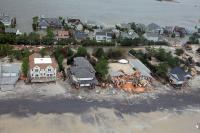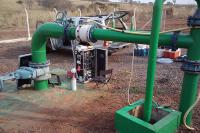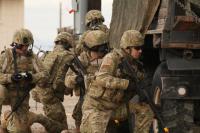-
Cities can prepare for hurricane season by reforming shortsighted and outdated laws
In the past decade major storms have devastated U.S. coastal cities from Galveston to Atlantic City and New York. They also have ravaged inland capitals, including Baton Rouge, Richmond, and Montpelier. Ensuring that our cities have the legal infrastructure in place to build safer, more efficient, and more equitable neighborhoods and communities after storms is just as important as preparing homes and businesses to ride out those storms.
-
-
New USGS models help predict storm effects on beaches

As the 2016 hurricane season opens, weather forecasters, emergency managers and coastal residents have access to tools developed by the USGS which predict, more precisely than ever, where beach erosion and beachfront flooding will take place during hurricanes and other storms.
-
-
Groundwater extraction contributes less to sea level rise than previously thought

Groundwater extraction and other land water contribute about three times less to sea level rise than previous estimates, according to a new study. The study does not change the overall picture of future sea level rise, but provides a much more accurate understanding of the interactions between water on land, in the atmosphere, and the oceans, which could help to improve future models of sea level rise.
-
-
Changing climate threatens World Heritage, tourism sites
Climate change is fast becoming one of the most significant risks for World Heritage sites across the globe. Many World Heritage sites, designated for their global significance and universal value to humankind, are major tourist destinations. Some are among the most iconic places on Earth.
-
-
Cotton candy machine inspires lighter bullet proof vests, and more

It is “boots on the ground” in this Harvard lab where the researchers are on a mission to protect U.S. troops on the battlefield. Researchersare developing next generation nanofibers at the Harvard Materials Research Science and Engineering Center (MRSEC). The researchers draw their inspiration from the cotton candy machine. They use their own version of that technology to spin a wide range of polymers, both natural and synthetic, into new fabrics and materials for military use.
-
-
Better understanding of how climate change threatens agriculture
Climate change expected over the next decade may cause food production in a key agricultural region of Brazil to decline by up to 13 percent. The decline reflects both reductions in crop yield — how much is produced per area harvested — and how crop failures and farmers’ decisions together lead to cultivating less land and growing only one crop in a season instead of two. “Some amount of climate change is inevitable,” says a researcher. “So we’re asking, How vulnerable is the agricultural system, and what are the remedies?”
-
-
Trump-owned resort cites sea level rise in application for seawall permit
Donald Trump may believe that the scientific evidence about global warming is a “hoax,” or the result of a Chinese plot to undermine the American economy, but the professional managers of his coastal properties believe that global warming is real, and that one of its consequences – sea level rise – poses a real threat to the Trump properties they manage.
-
-
Changing land uses in California will drive water needs beyond available supply
If past patterns of California land-use change continue, projected water needs by the year 2062 will increase beyond current supply. If historical trends of land use changes to or from urban, agricultural or other uses continue, the result will be increased water-use demand beyond what existing supplies can provide. Large uncertainties associated with weather and climate variability have the potential to exacerbate the problem.
-
-
Frequency of extreme heat waves on the increase in Africa -- could soon occur annually

Climate analysis shows that periods of unusually hot weather are on the rise for one of the most vulnerable continents to climate change, even if the increase in global average temperature remains at a modest level.Longer, hotter, more regular heat waves could have a damaging effect on life expectancy and crop production in Africa warn climate say scientists.
-
-
With drought easing, California rolls back water conservation rules
California announced on Wednesday that it was rolling back mandatory water conservation rules which were put in place at the height of a 4-year drought. The decision to roll back the restrictions came after water conditions in many parts of the state have improved as a result of a wet winter.
-
-
Maryland identifies health vulnerabilities resulting from climate change
As world leaders convened in Washington, D.C. a couple of weeks ago for the Climate Action 2016 summit, a new report by Maryland public health leaders details the impacts of climate change on the health of Marylanders now and in the future. The report examines the relationship between exposure to extreme weather events and risk of selected health outcomes including food and waterborne illnesses, hospitalization for heart attacks and asthma, and motor vehicle accidents.
-
-
Cybersecurity cracks the undergraduate curriculum
In a time when million-dollar security breaches of household name corporations regularly make headlines and complicate lives, computer science undergraduates at America’s universities remain surprisingly underexposed to basic cybersecurity tactics. the Software Assurance Marketplace (SWAMP), a national cybersecurity facility housed at the Morgridge Institute for Research in Madison, Wisconsin, has been working to address this skills gap by offering a suite of software security tools that Bowie State has been integrating into undergraduate coding courses, giving students a way to examine and rid their code of security weaknesses.
-
-
Trend continues: April 2016 the seventh consecutive warmest month on record
April 2016 was the warmest April on record for the globe, according to NASA. every month from October 2015 to April 2016 has now been warmer by 1 degree Celsius or more above the 1951-1980 average. Parts of Alaska, Russia, western Greenland, and northern Africa had a temperature deviation of at least 4 degrees Celsius above the April average.
-
-
Floods, coastal erosion may expose contents of UK landfills
The contents of historic coastal landfill sites in England and Wales could pose a significant environmental threat if they erode, according to a new study. The main risks to these landfills come from the effects of climate change, including erosion and flooding with salt water from storm surges and higher water levels.
-
-
Sea-level rise has claimed five whole islands in the Pacific: first scientific evidence
Sea-level rise, erosion, and coastal flooding are some of the greatest challenges facing humanity from climate change. Recently at least five reef islands in the remote Solomon Islands have been lost completely to sea-level rise and coastal erosion, and a further six islands have been severely eroded. This is the first scientific evidence that confirms the numerous anecdotal accounts from across the Pacific of the dramatic impacts of climate change on coastlines and people.
-
- All
- Regional
- Water
- Biometrics
- Borders/Immig
- Business
- Cybersecurity
- Detection
- Disasters
- Government
- Infrastructure
- International
- Public health
- Public Safety
- Communication interoperabillity
- Emergency services
- Emergency medical services
- Fire
- First response
- IEDs
- Law Enforcement
- Law Enforcement Technology
- Military technology
- Nonlethal weapons
- Nuclear weapons
- Personal protection equipment
- Police
- Notification /alert systems
- Situational awareness
- Weapons systems
- Sci-Tech
- Sector Reports
- Surveillance
- Transportation
Advertising & Marketing: advertise@newswirepubs.com
Editorial: editor@newswirepubs.com
General: info@newswirepubs.com
2010-2011 © News Wire Publications, LLC News Wire Publications, LLC
220 Old Country Road | Suite 200 | Mineola | New York | 11501
Permissions and Policies
Editorial: editor@newswirepubs.com
General: info@newswirepubs.com
2010-2011 © News Wire Publications, LLC News Wire Publications, LLC
220 Old Country Road | Suite 200 | Mineola | New York | 11501
Permissions and Policies
